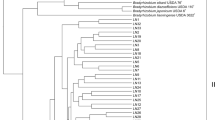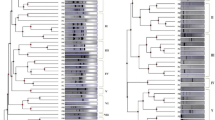Abstract
Bacillus thuringiensis (Bt) is a soil-dwelling bacterium of great interest for agronomical research because of its use as biological pesticide. There are some limitations regarding the subspecies classification. Phenotyping and genotyping studies are important to ascertain its variability. The diversity of 40 environmental strains, isolated from different regions in Mexico, was analyzed by ERIC-PCR and the ability of biofilm formation. Thirty-nine different fingerprinting patterns revealed enough data to discriminate among the 40 strains. A total of 24 polymorphic fragments with sizes between 139 and 1,468 bp were amplified. Almost all (95 %) strains showed biofilm formation after 96 h of incubation. At 96 h of incubation the biofilm-forming strains from the CINVESTAV collection showed a more heterogeneous ability as biofilms producers. Results showed a large intra-species genomic variability in Bt. However, some strains could be correlated as they were found within clusters depending on the location of isolation.


Similar content being viewed by others
References
Akhurst RJ, Lynes EW, Zhang QY, Cooper DJ, Pinnock DE (1997) A 16S rRNA gene oligonucleotide probe for identification of Bacillus thuriengiensis isolates from sheep fleece. J Invertebr Pathol 69:24–31
Auger S, Ramarao N, Faille C, Fouet A, Aymerich S, Gohar M (2009) Biofilm formation and cell surface properties among pathogenic and nonpathogenic strains of the Bacillus cereus group. App Environ Microbiol 75(20):6616–6618. doi:10.1128/AEM.00155-09
Bourque SN, Valero JR, Lavoie MC, Levesque RC (1995) Comparative analysis of the 16S to 23S ribosomal intergenic spacer sequences of Bacillus thuringiensis strains and subspecies and of closely related species. Appl Environ Microbiol 61:1623–1626
Bravo A, Sarjeet SG, Soberon M (2007) Mode of action of Bacillus thuringiensis Cry and Cyt toxins and their potential for insect control. Toxicon 49(4):423–435
Brousseau R, Saint–Orange A, Pre Fontain G, Masson L, Cabana J (1993) Arbitrary primer polymerase chain reaction a powerful method to identify Bacillus thuringiensis serovar and strains. Appl Environ Microbiol 59:114–119
de Bruijn FJ (1992) Use of repetitive (extragenic palindromic and enterobacterial repetive intergenic consensus) sequences and the polymerase chain reaction to fingerprint the genomes of Rhizobium meliloti isolates and other soil bacteria. Appl Environ Microbiol 58:2180–2185
Gomez de Leon P, Santos JI, Caballero J, Gomez D, Espinosa LE, Moreno I, Piñero D, Cravioto A (2000) Genomic variability of Haemophilus influenzae isolated from Mexican children determined by using enterobacterial repetitive intergenic concensus sequences and PCR. J Clin Microbiol 38:2504–2511
Hansen BM, Damgaard PH, Eilenberg J, Pederson JC (1998) Molecular and phenotypic characterization of Bacillus thuringiensis isolated from leaves and insects. J Invetebr Pathol 71:106–144
Helgason E, Caugant DA, Olsen I, Kolsto AB (2000) Genetic structure of population of Bacillus cereus and Bacillus thuringiensis isolates associated with peridontitis and other human infections. J Clin Microbiol 38:1615–1622
Hsueh YH, Somers D, Wong ACL (2008) Characterization of the codY gene and its influence on biofilms formation in Bacillus cereus. Appl Environ Microbiol 189:557–568. doi:10.1007/s00203-008-0348-8
Hsueh YH, Somers EB, Lereclus D, Wong ACL (2006) Biofilm formation by Bacillus cereus is influenced by PlcR, a pleiotropic regulator. Appl Environ Microbiol 72:5089–5092. doi:10.1128/AEM.00573-06
Jensen GB, Larsen P, Jacobsen BL, Madssen B, Smidt L, Andrup L (2002) Bacillus thuringiensis in fecal samples from greenhouses workers after exposure to B. thuringiensis-based pesticides. Appl Environ Microbiol 68:4900–4905. doi:10.1128/AEM.68.1.4900-4905.2002
Joung KB, Cote JC (2001) A phylogenetic analysis of Bacillus thuringiensis serovars by RFLP-based ribotyping. J Appl Microbiol 91:279–289
Katara J, Deshmukh R, Singh NK, Kaur S (2012) Molecular typing of native Bacillus thuringiensis isolates from diverse habitats in India using REP-PCR and ERIC-PCR analysis. J Gen Appl Microbiol 58:83–94
Kierek K, Watnick P (2003) Environmental determinants of Vibrio cholerae biofilm development. Appl Environ Microbiol 69:5079–5088. doi:10.1128/AEM.69.9.5079-5088.2003
Kumar CG, Anad SK (1998) Significance of microbial biofilms in food industry: a review. Int J Food Microbiol 42:9–27. doi:10.1016/S0168-1605(98)00060-9
Kuroki R, Kawakmi K, Qin L, Kaji CH, Watanabe K (2009) Nosocomial bacteremia caused by biofilm-forming Bacillus cereus and Bacillus thuringiensis. Inter Med 48:791–796. doi:10.2169/internalmedicine.48.1885
Lima ASG, Guidelli AM, Abreu IL, Lemos MVF (2002) Identification of new isolates of Bacillus thuringiensis using rep-PCR products and δ-endotoxinelectron microscopy. Gen Mol Biol 25(2):225–229
Lupski JR, Weinstock GM (1992) Short interspersed repetitive DNA sequences in prokaryotic genomes. J Bacteriol 174:4525–4529
Malkawi HI, al-Momani F, Meqdam MM, Saadoun I, Mohammad MJ (1999) Detection of genetic polymorphism by RAPD-PCR among isolates of Bacillus thuringiensis. New Microbiol 22:241–247
Musser JM, Barenkamp SJ, Granoff DM, Selander RK (1986) Genetic relationships of serologically nontypable and serotype b strains of Haemophilus influenzae. Infect Immun 52(1):18
Musser JM, Kroll JS, Granoff DM, Moxon ER, Brodeur BR, Campos J (1990) Global genetic structure and molecular epidemiology of encapsulated Haemophilus influenzae. Clin Infect Dis 12(1):75–111. doi:10.1093/clinids/12.1.75
Nagorska K, Ostrowski A, Hicn K, Holland IB, Obuchowski M (2010) Importance of eps gens from Bacillus subtillis in biofilm formation and swarming. J Appl Genet 51:369–381
Orskov F, Orskov T, Evans DJ, Sack RB, Sack DA, Wadstrom T (1976) Special Escherichia coli serotypes among enterotoxigenic strains from diarhoea in adults and children. Med Microbiol Immunol 162:73–80
Pattanayak D, Chakrabarti SK, Kumar PA, Naik PS (2001) Characterization of genetic diversity of some serovar of Bacillus thuringiensis. World J Microbiol Biotechnol 16:667–672
Priest FG, Goodfellow M, Todd C (1988) A numerical classification of the genus Bacillus. J Gen Microbiol 134:1847–1882
Reyes-Ramirez A, Ibarra J (2005) Fingerprinting of Bacillus thuringiensis type strains and isolates by using Bacillus cereus group-specific repetitive extragenic palindromic sequence-based PCR analysis. Appl Environ Microbiol 71:1346–1355
Sauka DH, Basile JI, Benintende G (2011) Evidence of Bacillus thuringiensis intra-serovar diversity revealed by Bacillus cereus group-specific repetitive extragenic palindromic secuence-based PCR genomic fingerprinting. J Mol Microbiol Biotechnol 21(3–4):90–184. doi:10.1159/000335532
Schnepf E, Crickmore N, Van Rie J, Lereclus D, Baum J, Feitelson J, Zeigler DR, Dean DH (1998) Bacillus thuringiensis and its pesticidal crystal proteins. Microbiol Mol Biol Rev 62(3):775–806
Shangkuan YH, Chang YH, Yang JF, Lin HC, Shaio MF (2001) Molecular characterizacion of Bacillus anthracis using multiplex PCR, ERIC-PCR and RAPD. Lett Appl Microbiol 32:139–145
Sonenshein AL (2005) CodY, a global regulator of stationary phase and virulence in gram-positive bacteria. Curr Opin Microbiol 8:203–207. doi:10.1016/j.mib.2005.01.001
Stepanovic S, Vukovic D, Dakic I, Savie B, Svabic-Vlahovic M (2000) A modified microtiter-plate test for quantification of staphylococcal biofilm formation. J Microbiol Method 40:175–179
Swaminathan B, Ghassan M (1993) Molecular typing methods: definition, application and advantages. In: Persing L, Smith T, Tenover F, White T (eds) Diagnostic molecular microbiology. ASM press, Washington D.C., pp 26–50
Torres AA, Reyes VY, López LVE, De la Torre M (2000) Guerra entre insectos y microorganismos: una estrategia natural para el control de plagas. Avance y perspectiva 2:291–295
Vanegas LM, Correa CN, Morales MA, Martínez LA, Rúgeles GL, Jiménez IF (2009) Resistencia a antibióticos de bacterias aisladas de biopelículas en una planta de alimentos. Rev MVZ Córdoba 14(2):1677–1683
Versalovic J, Schneider M, de Brulin FJ, Lupski JR (1994) Genomic fingerprinting of bacteria using repetitive sequence-based polymerase chain reaction. Methods Mol Cell Biol 5:25–40
Vilain S, Pretorius JM, Theron J, Brozel VS (2009) DNA as an adhesin Bacillus cereus requires extracellular DNA to form biofilms. Appl Environ Microbiol 75(9):2861–2868. doi:10.1128/AEM.01317-08
Vilas-Boas GT, Lemos M (2004) Diversity of cry genes and genetic characterization of Bacillus thuringiensis isolated of Brazil. Can J Microbiol 50:605–6013
Whalon ME, Wingerd BA (2003) Bt: mode of action and use. Arch Insect Biochem Physiol 54(4):11–200
Wijman JGE, Leeuw PPLA, Moezelaar R, Zwietering MH, Abee T (2007) Air-liquid interface biofilms or Bacillus cereus: formation, sporulation and dispersion. Appl Environ Microbiol 73:1481–1488. doi:10.1128/AEM.01781-06
Wilson BA, Salyers AA (2003) Is the evolution of bacterial pathogens an out of body experience? Trends Microbiol 11(8):347–350. doi:10.1016/S0966-842X(03)00179-3
Acknowledgments
Two Grants from Dirección General de Asuntos Académicos, Universidad Nacional Autónoma de México (DGAPA-UNAM) through its Programa PAPIIT (No. IN208410-3 and IN214414) and also one of CONACYT (No. 117943 M) supported this study. Dr. Karina García-Gutiérrez is the recipient of a fellowship from the Programa Posdoctoral DGAPA-UNAM. Dafne Gutiérrez received a fellowship from CONACYT, Mexico. We thank the excellent technical support from Jorge Sanchez, Liliana Hernández and Regina Basurto. These data were partially presented at the XI Meeting on Women’s Participation in Science, May 15, 2014, held in León, GTO. Mexico. The authors also thank Ingrid Mascher and Dr. José Luis Pérez-García for editorial assistance and for reviewing the proper usage of English in this manuscript.
Author information
Authors and Affiliations
Corresponding author
Rights and permissions
About this article
Cite this article
García, K., Ibarra, J.E., Bravo, A. et al. Variability of Bacillus thuringiensis Strains by ERIC-PCR and Biofilm Formation. Curr Microbiol 70, 10–18 (2015). https://doi.org/10.1007/s00284-014-0675-8
Received:
Accepted:
Published:
Issue Date:
DOI: https://doi.org/10.1007/s00284-014-0675-8




